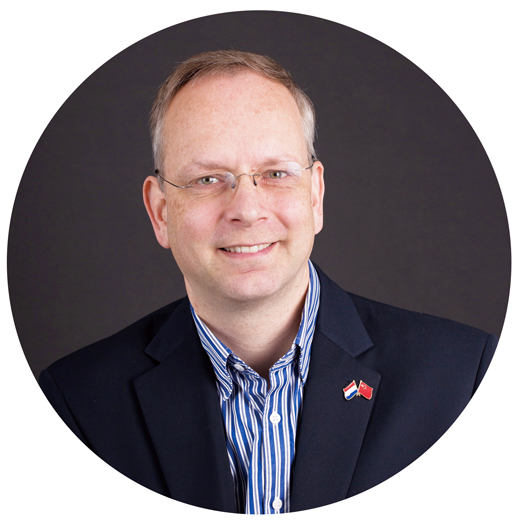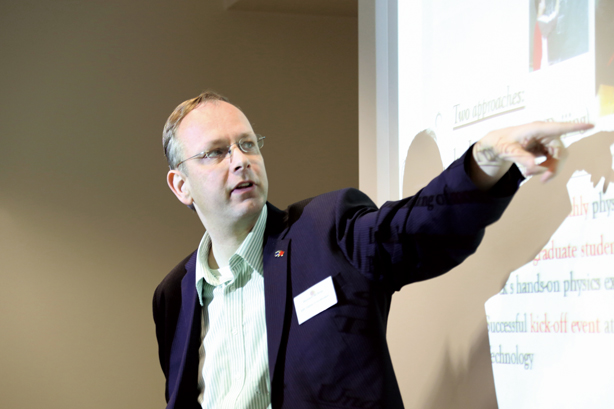
When Dutch astronomer Richard de Grijs first met Chinese astronomer DENG Licai at a workshop in Mexico in 2003, he was already married to a Chinese woman and interested in seeking links with Chinese astronomy. At that point, Richard was a junior faculty member at the University of Sheffield in the UK, while Licai was a research professor at the National Astronomical Observatories, Chinese Academy of Sciences (NAOC), in Beijing. They got along very well and forged a bond during those five weeks.
“You know,” Richard joked with Licai, “I have some ideas for PhD student projects but I have no students…”
“Well, I have two students. You can have them,” Licai replied, who was not joking.
That was the start of their collaboration. Richard went back to the UK, then travelled to Beijing and had long discussions with Licai’s team, which led to their co-supervision of two PhD students. The two became very good friends, and Licai has remained a strong supporter of Richard in the Chinese astrophysics community since then.
Before long, people from Peking University reached out to Richard. They were setting up a new international research institute, the Kavli Institute for Astronomy and Astrophysics (KIAA), and invited him to apply as a senior faculty member.
At the University of Sheffield, Richard had progressed through the ranks from a junior lecturer to associate professor, but he felt his career was stalled. So he applied for the job at the KIAA. The first year, he was not made an offer. The year after that, the KIAA enthusiastically encouraged him to apply again, and this time he made it.
It happened that his wife, a biologist, received a job offer from Tsinghua University around the same time. It seemed like excellent timing for the couple to move to China.

Richard de Grijs and his team in front of the KIAA building in June 2017.
Richard was already a frequent visitor to Beijing. He knew how different and hectic life could be here. He had experienced the air pollution, too, although the severity had not really registered with him at the time. The fact that he and his wife both got good job offers, and that there was drive and ambition in China, particularly at the Kavli Institute, made it easy for them to decide to move to China.
Richard joined the KIAA in September 2009. His research interests evolved from science that was mostly based on Hubble Space Telescope observations of the so-called “star clusters,” densely packed groups of thousands of stars, to embracing the research one can do with China’s domestic telescopes. In 2010 he completed a textbook on the state-of-the-art approaches to determining distances to remote astrophysical objects, which he later pursued by taking advantage of a new astronomical observatory in Delingha (Qinghai Province) that had been set up by Licai, with a telescope and other facilities.
With the ready availability of funding and access to excellent students at Peking University, Richard was able to do a lot of good science. His team published in top journals, including Nature. “I believe I’ve done more good science than I would have been able to do in the UK had I stayed there,” he says.

At the launch of the monthly "Fun with Science" sessions on April 21, 2012, Richard de Grijs conducts physics experiments with pupils from migrant schools at Beijing University of Chemical Technology.
He was very impressed by his students in China, especially the undergraduates. He often worked with them from their second year, and encouraged them to start their own projects early. The students began by reading introductory papers and doing basic data analysis. Then, by the end of their third or fourth year, this might result in a research paper in a scientific journal, which is an amazing opportunity for undergraduates.
“A large fraction of my students here are very bright and can think for themselves,” Richard says. It is an enormous joy for him to see the students grow into scientists, and some of them went on to study at world-level institutions such as Caltech, Harvard, Columbia and Berkeley.
At the same time, Richard found himself deeply involved in Beijing’s colorful science life. As representative of the Institute of Physics (UK) in China, he became friends with David Evans, the Royal Society of Chemistry’s representative here, who in turn introduced him to Helen Boyle. Helen runs the Migrant Children’s Foundation in Beijing and was enthusiastic about teaching the migrant children English, arts and all kinds of other subjects. So David and Richard asked her, “Would you like us to introduce them to science as well?”
That soon became a unique and unforgettable experience for Richard. Each month, Richard and David took their graduate students to a number of schools, where they spent the day with the migrant children doing simple physics and chemistry experiments using materials one can easily find around the home.
The kids loved it. The experiments were simple but fun. Richard remembers seeing the kids run to their parents and talk to them about it. “They were looking forward to us coming back every month,” Richard says. He does not expect all kids to take up a career in science, but he wants to expose them to the way of scientific thinking, which could hopefully benefit them in the future.
Richard also enjoyed other sorts of fun. For a long time he was a council member of the Royal Asiatic Society China in Beijing, an organization which organizes events, films, excursions, all related to the culture and history of China and the Far East. It was interesting to him because of both the subject matter and the people attracted by these activities, since he could easily find like-minded people at these events.
He felt comfortable in roles that went beyond his specialized scientific duties. For instance, he completed an innovative feature-length documentary about the past, present and future of Chinese astronomy with his Beijing-based Dutch filmmaker friend Rene Seegers, beating the odds to raise money and overcome organizational barriers. Meanwhile, his interests in the history of science developed into a 300-odd page book about longitude determination before the first sea clock was invented, which was published in 2017 by a prestigious British publishing house.
For years he was co-organizing monthly science cafes for general audiences in Beijing. He is also a regular columnist with china.org.cn, where he discusses Chinese developments in education and science.
Most of the time, Richard felt that he was well-accepted in China. This was a result of his efforts to establish good links with a number of key colleagues in the domestic astronomical community, including at NAOC and at Purple Mountain and Yunnan observatories. His academic colleagues were senior people who showed support by introducing Richard to more colleagues.
But occasionally he also encountered less welcoming sentiments in the community—“He’s a foreign scientist. He’s here only temporarily. He will leave again anyway.”
“That was never my plan,” Richard says. “My plan was to establish myself and stay in China for the long term.” In fact, he lived and worked in Beijing for eight and a half years. Although he recently left China, his residence in Beijing was much longer than most people had expected.

Richard de Grijs at the annual Institute of Physics (IOP) representatives' meeting in London in 2012, where he gives an overview of IOP-supported activities in China.
Richard is proud of his substantial collaborations with Chinese colleagues. “You know, it could’ve been just exchanges of people or expertise. Or, the approach of some of my foreign colleagues—they sometimes simply come to China to take away good students.” For Richard, it is important to establish a more equal level rather than things coming from one side. “I never came here just to take from the Chinese community.”
Indeed, he played the role of an “ambassador,” connecting the Chinese and international astronomical societies. He represented Chinese science at the International Astronomical Union at various levels, and he established the East Asian Office of Astronomy for Development in China.
Like many foreigners in China, Richard was haunted by the language barrier. All higher-level discussions in the community are held in Chinese, which prevented him from fully participating from the beginning.
But the key issues go beyond language problems. The main reason for his recent departure from China, he confesses, is “for reasons related to my longer-term future.” He was actually very happy in Beijing, but he realized a while ago that the country would not be his final destination. It occurred to him that when he gets older and if he had to go to a hospital, he could not even communicate properly with the doctors simply because they don’t speak English. He is also concerned about his pension, and figured that the conditions are currently “not there” in China to build up a good enough pension to retire decently outside of China.
He was also frustrated at leadership opportunities he had missed. There were at least two chances for him to obtain a higher-level administrative position; one time he was made an offer as a deputy head of a faculty of the University of the Chinese Academy of Sciences. The opportunity didn’t work out. He was specifically told that he was out because of his foreign citizenship.
“I feel there’s a glass ceiling for foreigners in China,” Richard says. He believes things have improved for foreigners at lower and intermediate levels, but not yet at senior levels. If a foreign scientist wanted to use the resources in China and stay and contribute as a researcher, that would be perfectly fine. However, if they wanted to be more ambitious and take on leadership roles within the community, it is still not possible at present without a Chinese passport and without speaking Chinese fluently.
These experiences prompted him to consider senior-level employment elsewhere.

Richard de Grijs visits the Primeval Structure Telescope (also called 21 Centimeter Array or 21CMA) in Xinjiang in 2008. The 21 CMA is a Chinese radio telescope array designed to detect the earliest luminous objects in the universe, including the first stars, supernova explosions and black holes. (Photos provided by Richard de Grijs)
His new job at Macquarie University in Sydney involves defining his new Faculty’s global engagement strategy. With the network he has built up here over the past eight years, Richard is expecting to continue working with his friends and colleagues in China, and he hopes to see more Chinese students come to Sydney.
He says he wants to build stronger links with the Chinese community, although this time as an outsider. In a few years’ time, he may also consider coming back part time on one of those programs for foreign professors. “I’m certainly not leaving China fully behind. I hope to be an advocate for Chinese science, but outside of China,” he says.

